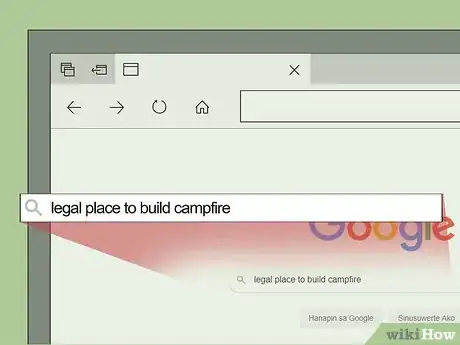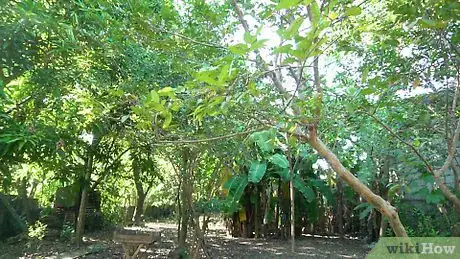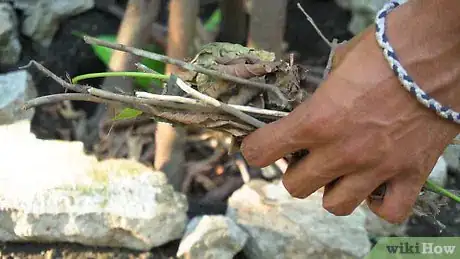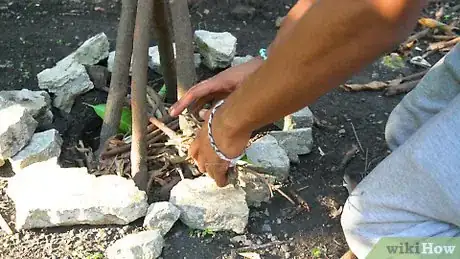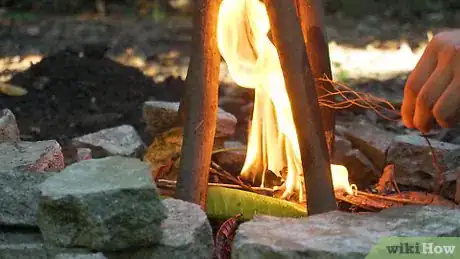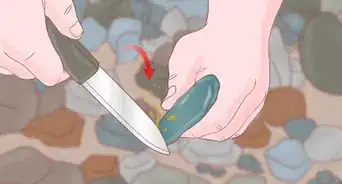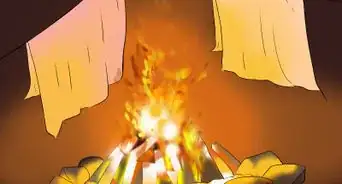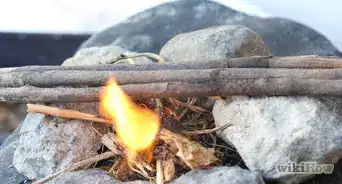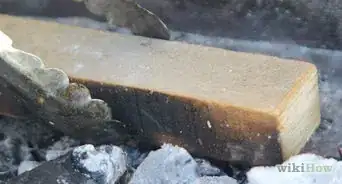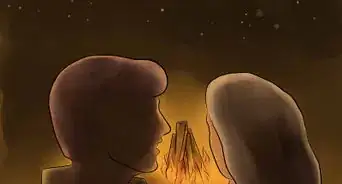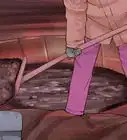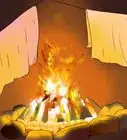This article was co-authored by Britt Edelen. Britt Edelen was an active member of his local Boy Scouts troop near Athens, Georgia from ages 8 to 16. As a Scout, he went on dozens of camping trips, learned and practiced many wilderness survival skills, and spent countless hours appreciating the great outdoors. In addition, Britt worked as a counselor for several summers at an adventure camp in his hometown, which allowed him to share his passion for and knowledge of the outdoors with others.
This article has been viewed 86,573 times.
The campfire is a primal thing – a powerful and deeply human thing. You can use a fire to stay warm, see at night, cook food, and keep away bugs, among other things. Starting a campfire is an essential camping skill, whether you are in the woods, on the beach, in the snow or in your backyard. Read on to learn how!
Steps
Preparing to Build a Fire
-
1Make sure that you can legally build a campfire. If the season or region is particularly dry, there might be restrictions on when, where, and why people can light fires. Check the local fire restrictions online or at a ranger station before you go. Some areas require you to register a campfire permit. You may only be able to build fires in designed "campfire" spots.[1]
- Respect the fire restrictions. They are in place for a reason! Only you can prevent forest fires.
-
2Acquire a campfire permit, if necessary. In the U.S., many National Forest and Bureau of Land Management areas require you to carry a permit for building a flame outside of a designated fire pit area. Visit any Forest Service, Department of Forestry and Fire Protection, or Bureau of Land Management office to ask for a permit sheet. In some areas, such as California, you can download a campfire permit online.[2]Advertisement
-
3Find a low, dry, sheltered space. In order to protect your fire from the wind, you should build your campfire on ground that is lower than the land around it. Consider setting up the fire in an alcove against a rock or cliff face that will protect the flames from the wind – but be careful not to leave burn marks on the rock! Make sure that the ground is dry, and that there is no chance of your spot being exposed to rain.
- If you are in a forest, look for a large clearing and build your fire near the center. This way, the flames won't lick too close to the surrounding trees.
- If you're expecting rain, you have two options: build the fire within a natural shelter, like a cave or an overhang; or tie up your own protective cover using a tarp or a tent fly.
-
4Build the fire pit. First, dig a shallow hole—no more than 3-8 inches deep— so that the fire is protected from the wind. Then, line the rim of the pit with stones or a thick berm of earth. This protective barrier will help retain the heat, and it should keep the fire from spilling beyond its boundaries.
- Use large stones (as big as your hand) to build the bulk of the barrier, then use smaller stones and soil to fill the cracks. Try to choose dry stones.
- If you cannot dig, you should still try to build a protective perimeter. Clear any twigs and leaves at least two feet away from the edge of your fire circle.
-
5Practice fire safety. Keep a water source nearby to extinguish the fire if need be. Make sure to clear flammable objects from the perimeter of the fire pit. Sweep away dry leaves, pine needles, twigs, and other things that might accidentally catch aflame. Clear a swath at least a foot wide.
- In a pinch, you can put out a fire by quickly shoveling earth or sand over the top.[3] However, there is no substitute for water.
Arranging Wood and Kindling
-
1Build a "tipi" or lean-to of logs. Search around your campsite for logs and large branches. The logs should be thick – about the diameter of your leg above the knee. Make sure to use dry, clean logs; avoid wood that is rotting, mossy, or waterlogged. Prop three or four logs against each other so that they provide shelter for your kindling, but also allow plenty of air to flow through your fire.
- Set aside extra logs for later. They will form the primary fuel for the fire once you've gotten it going.
- If you want a fire just for the evening, use softwood—pines, firs, and other trees with needles—as it will burn faster. If you want your fire to burn through the night, use hardwood: trees with leaves, like oak and birch.
-
2Gather kindling: twigs, leaves, and bark. This is the first part of your fire that will catch.[4] Make sure that they are completely dry. Depending on the ecosystem, it may take time to find enough twigs – so be patient. Search beneath trees and bushes where these bits may have fallen. Make a large pile of twigs near the campfire site.[5] Then, when they are gathered, carefully stack them in the center of the fire pit, between the legs of the "tipi."
-
3Gather small branches. These should be no thicker than an inch in diameter – about as thick as your thumb. Collect an armload or two of these branches. Once you have these branches, put them on top of your dry twigs in the fire pit.
- If you are burning hardwood, you want to use only fallen branches that are dead and very dry. If you are burning softwood, you can take the branches directly off the tree, needles and all.
-
4Prepare your tinder. This is the flammable material that you will burn to get the fire going. You can use thin bark, dry leaves, newspaper, cardboard, pine needles – anything that will catch fire quickly and ignite the wood.[6] Think of it as "fuse" that leads to your bed of dry twigs and leaves. Set aside plenty of tinder so that you can light the fire in several spots.
Lighting and Managing the Fire
-
1Protect the fire pit from the wind. Get down on your knees and place your tinder underneath your twigs. Place yourself between the fire and the wind. If there is a lot of wind, use your logs to create a barrier which will stop the breeze from buffeting your fire.
-
2Light the tinder. Strike a match or a lighter, then hold the flame directly beneath your paper. The tinder will catch and begin to burn. Use the same match to light the tinder in multiple places. Watch the fire carefully to make sure that the kindling (twigs, leaves, bark) catches and stays ablaze.
- Try fanning the flames to push airflow through the kindling. Fire catches best when there is a slight breeze, but not enough to blow it out.
-
3Stack more branches on the fire. As the kindling catches, proceed to place larger and larger branches on top of it until you can no longer see the flames. Be patient, and don't add too much at once. Make sure to leave plenty of gaps for airflow – you don't want to suffocate the fire.[7]
-
4Put a log on the fire. Once the blaze burns through the larger branches, heave one large log onto the top of the kindling. Again, make sure not to stifle the fire. After ten minutes, put two more logs onto the fire, along with a few more large branches. Add fuel every 45 minutes, or as needed.
-
5Maintain the fire. Keep an eye on the flame to make sure that it doesn't get out of control; watch where the sparks are landing, and be aware of where the wind is blowing. From time to time, stoke the heart of the fire with a long stick to push the embers to the surface. Knock off charred portions of log in order to expose new wood to the flame. When the fire gets low, add more branches or another log.
-
6Know how to put out a campfire. Make sure to extinguish the flames before abandoning the campsite, going to sleep, or otherwise leaving the fire unattended. If possible, wait for the fire to naturally burn down to the embers. Start by shoveling dirt or sand into the pit to subdue the blaze. Then, when the fire is just coals, pour water over the embers until they have cooled – when they are no longer giving off steam.[8]
- Avoid pouring water directly onto a blazing fire. This will extinguish the flames quickly, but it will also throw up a large cloud of dust and steam. Be patient.
- When the fire is out, fill in the pit completely with dirt. If you are camping in the backcountry, consider scattering the stones, rearranging the leaves, and returning the space to the way it was when you found it.
Expert Q&A
-
QuestionWhat materials do I need to start a campfire?
 Britt EdelenBritt Edelen was an active member of his local Boy Scouts troop near Athens, Georgia from ages 8 to 16. As a Scout, he went on dozens of camping trips, learned and practiced many wilderness survival skills, and spent countless hours appreciating the great outdoors. In addition, Britt worked as a counselor for several summers at an adventure camp in his hometown, which allowed him to share his passion for and knowledge of the outdoors with others.
Britt EdelenBritt Edelen was an active member of his local Boy Scouts troop near Athens, Georgia from ages 8 to 16. As a Scout, he went on dozens of camping trips, learned and practiced many wilderness survival skills, and spent countless hours appreciating the great outdoors. In addition, Britt worked as a counselor for several summers at an adventure camp in his hometown, which allowed him to share his passion for and knowledge of the outdoors with others.
Outdoor Educator You'll need dry leaves, bark, and smaller branches to use as kindling to help your fire get started. For longer, sustained burns, look for logs to add to your fire. Balance out using kindling and large logs so you don't snuff out your fire.
You'll need dry leaves, bark, and smaller branches to use as kindling to help your fire get started. For longer, sustained burns, look for logs to add to your fire. Balance out using kindling and large logs so you don't snuff out your fire. -
QuestionOther than a fire extinguisher, wood, wet sand, zinc sheets, and kerosene, should I have anything else when making a campfire?
 Community AnswerYou might also need matches and kindling to get the fire started. Also, having a shovel and water on-hand is a good idea, as most areas where you can make a campfire (during low and moderate fire danger) require you to completely extinguish a fire to prevent forest fires.
Community AnswerYou might also need matches and kindling to get the fire started. Also, having a shovel and water on-hand is a good idea, as most areas where you can make a campfire (during low and moderate fire danger) require you to completely extinguish a fire to prevent forest fires. -
QuestionWhat is the best accelerant for a camp fire?
 Community AnswerLighter fluid.
Community AnswerLighter fluid.
Warnings
- Never light a fire near flammable material.⧼thumbs_response⧽
- Exercise caution when using lighters or matches.⧼thumbs_response⧽
- Make sure fires are allowed.⧼thumbs_response⧽
Things You'll Need
- Wood
- Matches or lighter
- Axe (optional)
- Paper, bark, or other tinder
References
- ↑ http://www.fire.ca.gov/communications/communications_firesafety_redflagwarning
- ↑ http://www.fs.usda.gov/detail/sierra/passes-permits/?cid=fsbdev7_018116
- ↑ Britt Edelen. Outdoor Educator. Expert Interview. 7 February 2020.
- ↑ http://www.artofmanliness.com/2008/09/04/how-to-build-a-roaring-campfire/
- ↑ Britt Edelen. Outdoor Educator. Expert Interview. 7 February 2020.
- ↑ http://www.reserveamerica.com/outdoors/how-to-start-a-campfire.htm
- ↑ Britt Edelen. Outdoor Educator. Expert Interview. 7 February 2020.
- ↑ http://www.active.com/outdoors/articles/campfire-starters-that-never-fail
About This Article
To start a campfire, start by digging a shallow hole and lining the rim of it with rocks. Then, prop up 3 or 4 logs against each other in the center of the pit so they form a teepee, and stuff dry leaves, twigs, and bark inside of it. Next, place some small branches on top of the dry kindling, and light the kindling to start the fire. Finally, continue to stack more branches on top of the fire as it grows, and eventually place a few logs on top. For tips on how to practice fire safety, keep reading!
